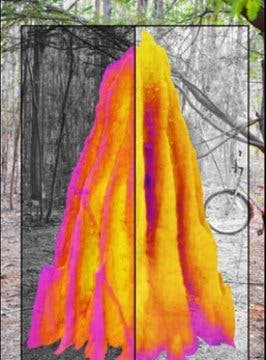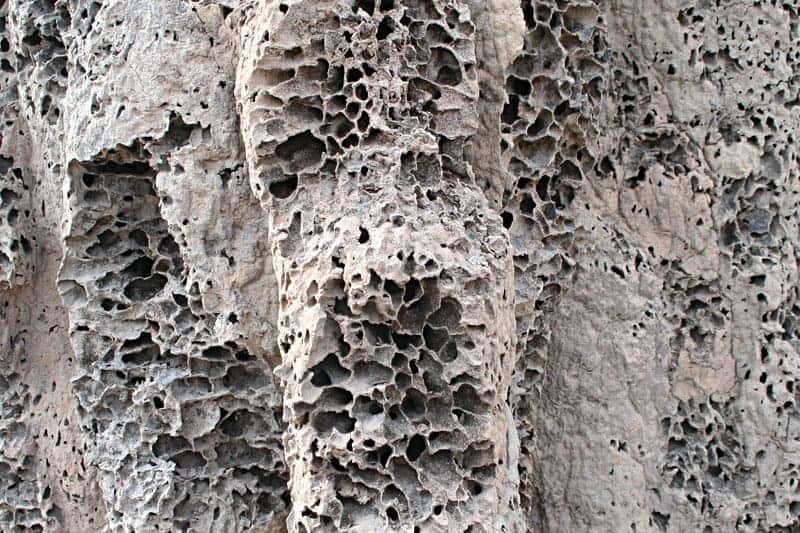The humble termite only has its body, saliva and some soil to work with, and the only blueprints it has are instinctual, based on variations in wind speeds and fluctuations in temperature as the sun rises and sets. Working with such limited resources, they still erect monumental mounds that, a new study reveals, rely on a surprisingly well-tuned mechanism for efficient ventilation, something architects today still struggle with.
Led by L. Mahadevan, Lola England de Valpine Professor of Applied Mathematics, of Organismic and Evolutionary Biology, and of Physics, a team of researchers that included Hunter King, a post-doctoral fellow and Samuel Ocko, a graduate student, both in the Mahadevan lab, has for the first time has described in detail how termite mounds are ventilated. The study reveals that the structures act akin to a lung, inhaling and exhaling once a day as they are heated and cooled.

Credit: Hunter King and Naomi Ocko
The study is described in an August 31 paper in the Proceedings of the National Academy of Sciences (USA).
“The direct measurements essentially overthrow the conventional wisdom of the field,” Mahadevan said. “The classic theory was that if you have wind blowing over the mounds, that changes the pressure, and can lead to suction of CO2 from the interior…but that was never directly measured. We measured wind velocity and direction inside the mounds at different locations. We measured temperature, CO2 concentrations…and found that temperature oscillations associated with day and night can be used to drive ventilation in a manner not dissimilar to a lung. So the mound ‘breathes’ once a day, so to speak.”
On a trip to the National Center for Biological Sciences in India five years ago, Mahadevan was surprised to learn that many of the theories about how exactly the termites’ mounds function had not been rigorously tested. Working with Scott Turner, an Associate Professor at SUNY College of Environmental Science and Forestry, and author of a book that examines animal-built structures, Mahadevan, King and Ocko put together a plan to set out to find more definitive answers.
“It occurred to us that the internal flow profiles predicted by different potential mechanisms qualitatively disagree with each other,” King said. “By measuring them directly, we could easily identify the right one. The hard part was figuring out how to sensitively measure these small flows in a confined space defended by glue-and-mud-excreting termites.”
Over a period of several weeks they used a series of custom designed probes to conduct a variety of tests on both live and dead mounds that included temperature readings during the day or at night, covering the mounds with tarps, blowing air over the structures and even using vacuum cleaners to test suction throughout it’s internal passages.
“After months of hard thought and preparation, it all comes down to hiking through the woods at 4am with a laptop, a lantern, custom-built electronics, and a hole saw,” Ocko said. “The ‘aha’ moment made it all worth it.”
As they found out, the ventilation mechanism is in large measure built into the mounds themselves. There is a large central chimney that spans from the gallery — the underground chamber where most of the colony lives — to the top of the mound. The interior, structural walls that make up the core of the mound are larger, bulkier and more resilient, but the exterior ones are far thinner. While impermeable to winds, these outer walls allow for an exchange of gasses with the environment.

Image via matnkat
During the day, Mahadevan explained, as sunlight either directly or indirectly warms the mound’s outer walls, the air inside warms, causing it to rise.
“What you get is a convection cell,” Mahadevan explained. “The warm air can’t move through the walls quickly enough, but it has to go somewhere, and the only possibility is for it to go down into the interior through the central chimney. At night, as the exterior cools, the airflow reverses, and it pulls the air up from the central part of the mound.”
The end result is that while CO2 concentrations during the day can reach up to four or five percent in the center of the mound, the airflow at night pulls the gas to the exterior walls, where it can escape by diffusing through the wall.
“But what’s remarkable here is how the termites are using transients. The temperature outside the mound is oscillating, and they have developed a method to harness that to ventilate their mounds.” Mahadevan said.
While the study reveals for the first time how termite mounds truly work, it may also offer lessons human architects could benefit from.
“In a large building like the one we’re sitting in we have windows and doors that allow us a certain amount of seclusion and privacy, but that also means you have a harder time pushing air around from one part of the building to another,”
While the notion of designing buildings that can be more efficiently ventilated is not new, the principles described in the study might offer new ways to think about such passive ventilation systems.
“Could you drive large scale flows through a building like this one by cleverly opening and closing doors and windows ?” Mahadevan asked. “Rather than spending a great deal of energy for a fan and air conditioning in every room, with the end result being that some people are too hot and some people are too cold… perhaps we should think of the entire thing as a system and these new measurements suggest that if the architecture is appropriate, ventilation can occur by using environmental transients — something for us to think about.”


